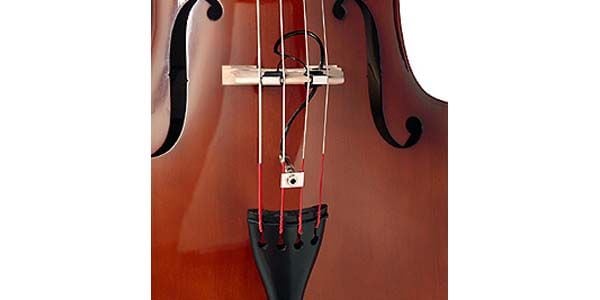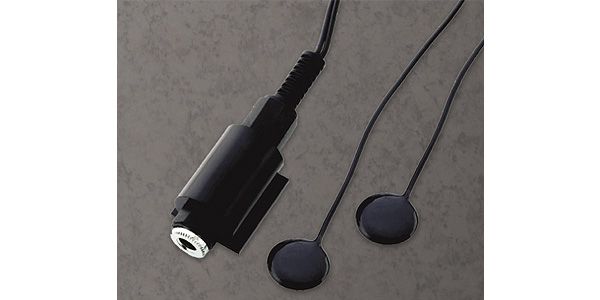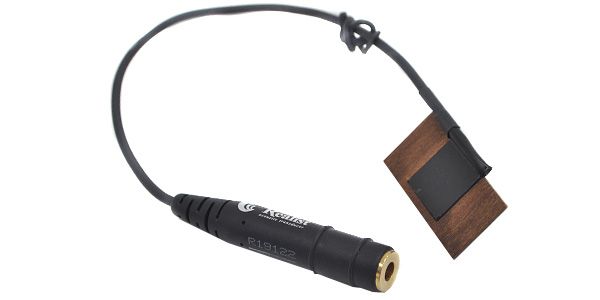Hello, everyone. This time I would like to write about double bass.
Double basses are often used for jazz and pop music as well as classical music. The sexy bass tone attracts many people, doesn’t it?
Nowadays, it is common to use a microphone, pickup, and so on to pick up the sound, and there are many choices.
You may be wondering which one to use. I’m going to introduce some recommended pickups in hopes that this will be of help.
* Though magnetic pickups are used for double basses, as well as piezo pickups, magnetic pickups cannot be used with gut or nylon strings due to their nature. So I am not going to introduce magnetic pickups this time. I am going to introduce only piezo pickups that can be used for anything.
Double bass pickups are roughly divided into three types: clamp type, taped type, and the under-saddle type. The advantages and disadvantages of each are described below.
First, the Fishman BP100 is a typical clamp type.
FISHMAN / BP-100 Classic Series Upright Bass Pickup
It can easily be installed and it is strong against feedback.
On the other hand, the sound tends to be crisp and often requires fine adjustment. If you use an amplifier and don't send the signal to the PA directly, you can adjust it with the amplifier, but when you send it to the PA directly, you have to leave it to the PA staff to adjust the sound with a preamplifier or equalizer, or you can alter the pickup itself, aiming for a sound that does not require adjustment. It's interesting, but I think many people will find it a little annoying.
Next is the taped type. It can be installed on the body or saddle with tape.
A typical model is the Shadow SHSB.
SHADOW / SH SB
This is really interesting. The sound is different depending on where you attach the pickups, on the bass string side, in the center of the saddle, on the high string side, near the F hole, under the fingerboard, or behind the fingerboard. It's fun to try to find your favorite position.
On the other hand, it is difficult to install it firmly. If you use double-sided tape with a weak adhesive, it will fall off. However, using a stronger tape, it may damage the finish of the instrument. It's best to stick it with an adhesive, but this will cause damage to the finish 100%, no questions asked ... It becomes a great dilemma, but I think there are a lot of things you can learn from this pickup, so I would recommend you to try it once.
Finally, a type that is attached under the saddle (basically on the bass string side). A typical one is the REALIST / WBASS-PICK UP. I also use the WOODTYPE.
REALIST / WBASS-PU WOODTYPE
Probably this type gives the best sound if you put it normally (without any alterations). On the other hand, it may cause scratches between the body and the saddle, and the string height changes as the height of the saddle changes, so you’ll need to adjust it, and if you install it yourself, you need to work carefully so that the sound post does not fall. It can be quite troublesome. However, since the scratches are under the saddle, you cannot see them, and I think the height will not bother you unless you prefer extremely low strings, and if you are not confident with doing the installation, you can bring it to a musical instrument store to get it done.
That is all for the introductions.
Next, I would like to write about feedback. This depends not only on the equipment you are using, but also on the size of the venue, other instruments (feedback tends to occur when there are many acoustic instruments), the music genre (because sound varies depending on the genre), and whether you are recording or playing live. I don't think there is a way to deal with all situations while trying to get the desired sound. It may not be the best way, but I think it is better to use both a clamp type and an under-saddle type, and choose according to the your situation. It can be a hassle, but it's still a lot easier than using a microphone.
Finally, I would like to write about amplifiers.
When I was an active musician, Acoustic Image and Phil Jones bass amps were often used. Combo amps were more popular than stack amps (I often saw them in small live houses, I think they were used to correct live sounds). When using stack amps, cabinets with a typical 15-inch speaker + multiple midrange speakers (such as two 10-inch units), rather than a tweeter, were popular. Many people prefered a clear sound rather than a fat sound. Especially, the response of the low position was usually slow, so amps with a good response were preferred. I personally like the Markbass. I think that many Ampeg users use tube amps. Unlike electric guitars, the sound is very fat, so the warmth that is a feature of tube amps often backfires and sound gets blurred.
* Today, the progress of equipment has been remarkable. I wrote this based on my experiences more than 10 years ago, so things may be different now.
Thank you for reading!
コラム「sound&person」は、皆様からの投稿によって成り立っています。
投稿についての詳細はこちら





























